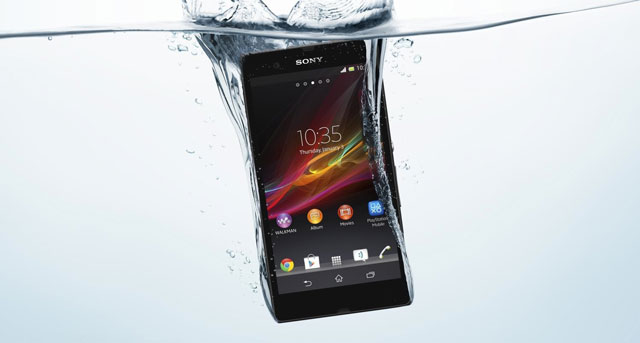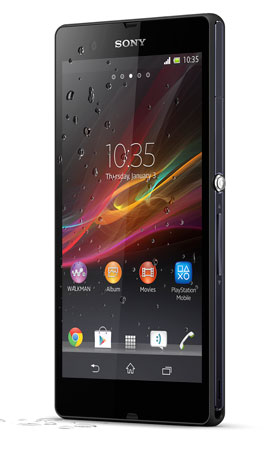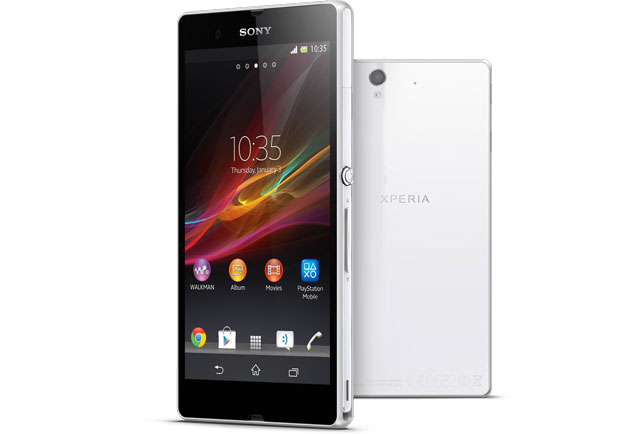
With Samsung and Apple dominant in the smartphone wars, Japan’s Sony has had to battle for the Android scraps with companies like HTC. With the Xperia Z, however, the company has done a superb job of catching up with the frontrunners and, in certain respects, even overtaking them.
Unveiled at the Consumer Electronics Show in Las Vegas in January, the Xperia Z is big and beautiful and packed with attention-grabbing features. It’s without doubt the finest handset Sony has made since it split its cellphone joint venture with Sweden’s Ericsson and easily holds its own against HTC’s stunning new One Android “superphone”.
Sony’s really pulled out all the stops with the Xperia Z, including making it water resistant.
The 3,5mm audio jack and the micro USB port have covers. It’s a great differentiator and something seldom seen on high-end devices, unless they’re deliberately being marketed as “ruggedised”. Unfortunately, Sony has placed the USB port on the top left of the device, making it impossible to use with most audio or charging docks.
Premium device
Straight out of the box, the Xperia Z gives the impression of being a premium device. The front and rear are clad in glass, while the edges are wrapped in aluminium. Turn it on and that impression remains unchanged.
Like Samsung and HTC, Sony has opted for a 1080p full high-definition display for its new flagship device. Powered by the same Bravia engine Sony uses in its televisions, the Xperia Z’s 5-inch display is quite simply stunning. Pixels are impossible to discern with the naked eye, contrast is excellent, and the screen performs brilliantly in direct sunlight.
The TFT display is noticeably less saturated than the Amoled displays favoured by Samsung, but that arguably makes images and video look more realistic. Often Samsung’s colours are so saturated they look cartoon-like. The only mark against the Xperia’s display is that viewing angles aren’t as good as we’re accustomed to — turn the display more than a few degrees and the image softens.
Rather than having dedicated capacitive controls on the bezel surrounding the screen, Sony has chosen to use on-screen controls. In most applications, there’s a black bar at the bottom of the screen with “back”, “home” and “options” buttons. These disappear when viewing video or using other full-screen applications, allowing for maximum use of the display’s real estate.
Sony hasn’t tinkered too much with the default Android on the Xperia Z. Users are limited to five home screens and there are four default customisable shortcuts arranged along the bottom of each. Situated in the middle of the shortcuts is a button to open the applications menu.
The options button allows you to switch between open apps, but also brings up a selection of mini widgets like a countdown timer. It’s a well thought-out interface addition and another feature that shows just how much time Sony has invested here.
 The notifications menu has a row of five shortcuts along the top. These toggle sound settings, Wi-Fi, Bluetooth and mobile data, and offer a shortcut to the settings menu. The time and date are also displayed, but on the whole it’s a far simpler notifications menu than HTC’s or Samsung’s. Opening the messaging application for the first time gives you the option to choose between a regular software-based Qwerty keyboard, one that adds symbols and numbers to the top right hand corner of each letter key, and even a retro-looking 0-9 style keyboard that supports T9 predictive text. You can also choose whether or not you’d like a microphone key to enable Google’s dictation service.
The notifications menu has a row of five shortcuts along the top. These toggle sound settings, Wi-Fi, Bluetooth and mobile data, and offer a shortcut to the settings menu. The time and date are also displayed, but on the whole it’s a far simpler notifications menu than HTC’s or Samsung’s. Opening the messaging application for the first time gives you the option to choose between a regular software-based Qwerty keyboard, one that adds symbols and numbers to the top right hand corner of each letter key, and even a retro-looking 0-9 style keyboard that supports T9 predictive text. You can also choose whether or not you’d like a microphone key to enable Google’s dictation service.
The keyboard customisation options go so far as offering the option of full stop and comma keys that flank the spacebar. There’s also the option to swipe rather than type from the outset, without needing to download a third-party keyboard. We found text input on the Xperia Z fast and accurate. The autocorrect function is excellent, as is autocomplete.
Fittingly for a high-end device, the Sony handset supports all major frequency bands for 3G and 4G and includes all of the sensors smartphone users have come to expect, including an accelerometer, gyroscope and digital compass. It also includes a stereo radio – something Sony has always favoured but rivals often eschew.
Powered by version Android 4.1 “Jelly Bean”, the Xperia Z has a quad-core 1,5GHz processor, 2GB of RAM and 16GB of storage that can be expanded by a further 64GB using the microSD card slot. It’s little surprise, then, that moving between home screens and apps is fluid. Even with myriad applications running simultaneously, the Xperia Z remains fast and responsive.
With such a beautiful display, the phone really shines when watching video or browsing the Internet.
Superb optics
Sony has a long history of making fine optics, and it’s little wonder then that the Xperia Z has a superb shooter, too. The primary camera offers 13 megapixels, while the front-facing one offers a little over two. The on-screen controls are excellent and the autofocus is incredibly fast and accurate, but annoyingly there’s no dedicated shutter button, even though Sony opted to enable the volume rocker for zooming when it would be far more useful as a shutter release.
The images and 1080p video the Xperia Z produces are as good as anticipated and Sony’s made it simple to capture either stills or video from the default camera display by including an on-screen control for both at all times. There are plenty of scene modes to choose from, and framing on the 5-inch display is an absolute delight. If you opt to shoot in 4:3 aspect ratio rather than the default 16:9, the screen pillar-boxes accordingly.
Sony’s Walkman application makes great use of the display and offers intuitive navigation of music. Although the built-in speakers are nothing special, plug in headphones and the Xperia Z really shines. Sony’s included an option called ClearAudio+ to squeeze the most out of your audio files, and with headphones on it offers the kind of audio experience we’ve only previously enjoyed with HTC’s Beats-enabled devices.
Powered by a 2 330mAh battery, the Xperia Z should last a normal working day, even with 4G switched on. But in order to prolong battery life, there’s a “Stamina Mode” that allows you to make fine-grained decisions about which apps can check for new data and how often. We’d rather see a breakthrough in battery technology, but it’s a feature that actually seems to work and a step in the right direction.
TV integration
If you also happen to own a Sony television, you control it using the Xperia Z, something Samsung has done with its handsets, too. It’s also possible to mirror the Xperia Z’s screen on an external display should you so wish.
Like the included near-field communications chip, these features seem more like gimmicks than selling points, but they’re worth mentioning because they demonstrate how careful Sony has been to include everything a consumer could possible want from a modern smartphone.
The Xperia Z comes with a wide range of applications by default, including social media apps, a free version of OfficeSuite, all of the standard Google apps, and an application called Sony Car, which, as the name suggests, provides large shortcuts to the functions you’re most likely to want to access while driving. These include shortcuts to Google Maps navigation, audio and call options.
At R7 999, the Xperia Z has a price tag that aligns with the message Sony’s evidently trying to send: that it’s not out of the race for smartphone supremacy.
There’s no doubt Sony has thrown everything it has into designing the Xperia Z, and it’s succeeded. The device looks, feels and behaves like a flagship handset, and there are number of features that set it apart from rival offerings.
And, like the latest offerings from Samsung and HTC, Sony’s Xperia Z shows just how far Apple will have to go with the next iPhone if it hopes to catch up with – let alone outshine – the latest generation of Android-powered devices.
Like the HTC One, the Xperia Z deserves to sell millions of units. But like HTC, Sony will have to contend with the enormous brand awareness Samsung has cultivated. — (c) 2013 NewsCentral Media





